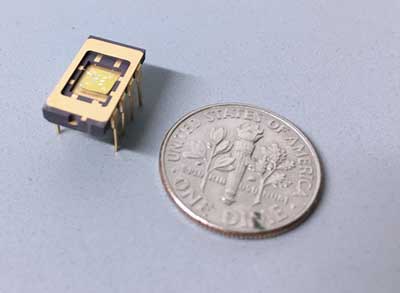| Dec 13, 2018 | |
Microscopic devices that control vibrations could allow smaller mobile devices(Nanowerk News) To make modern communications possible, today's mobile devices make use of components that use acoustic waves (vibrations) to filter or delay signals. However, current solutions have limited functionalities that prevent further miniaturization of the mobile devices and constrain the available communication bandwidth. |
|
| Now, a research team led by Chiara Daraio, Caltech professor of mechanical engineering, has developed new versions of these components with abilities previous incarnations did not possess. The components, known as phononic devices, could find uses in new kinds of sensors, improved cell phone technologies applied physics, and quantum computing. | |
 |
|
| A phononic device next to a dime for scale. (Image: Caltech) | |
| The phononic devices include parts that vibrate extremely fast, moving back and forth up to tens of millions of times per second. The team developed these devices by creating silicon nitride drums that are just 90 nanometers thick. (A human hair is about a thousand times thicker.) The drums are arranged into grids, with different grid patterns having different properties. | |
| Daraio, along with former Caltech postdoctoral scholar Jinwoong Cha showed that arrays of these drums can act as tunable filters for signals of different frequencies. They also showed that the devices can act like one-way valves for high-frequency waves. The ability to transmit waves in only one direction helps keep the signal stronger by reducing interference. | |
| These findings open opportunities to design new devices—such as phononic transistors and radio-frequency isolators—based on phonons instead of electrons, Cha and Daraio say. | |
| Their findings appears in two papers published in the journal Nature Nanotechnology ("Electrical tuning of elastic wave propagation in nanomechanical lattices at MHz frequencies") and Nature ("Experimental realization of on-chip topological nanoelectromechanical metamaterials"). |
| Source: Caltech | |
|
Subscribe to a free copy of one of our daily Nanowerk Newsletter Email Digests with a compilation of all of the day's news. |
